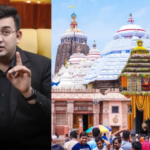Gyanvapi case reaches Supreme Court
UTTAR PRADESH, FEB 26 : The Muslim side filed an appeal in the Supreme Court against the Gyanvapi verdict given by the Allahabad High Court. The High Court had, earlier in the day, dismissed the Gyanvapi mosque management committee’s twin appeals.
The appeals were, in turn, directed against a Varanasi district court’s decision to permit puja in a cellar in the mosque complex.
On January 17, the Varanasi district judge had appointed the district magistrate as the receiver of the southern cellar of the mosque. On January 31, the Varanasi district court ruled that a priest can perform prayers before the idols in the southern cellar of the mosque.
Justice Rohit Ranjan Agarwal, while dismissing both the appeals of the Anjuman Intezamia Masjid (AIM), said in his order: “After going through the entire records of the case and after considering arguments of the parties concerned, the court did not find any ground to interfere in the judgement passed by the Varanasi district judge.”
The AIM had filed the appeal in the high court on February 1 soon after the Supreme Court had refused to hear the mosque committee’s plea against the order allowing the puja in the southern cellar.
Varanasi district judge Dr AK Vishwesha had allowed the puja in the southern cellar on the plea of Shailendra Kumar Pathak ‘Vyas’, a member of the Vyas family which had the cellar in its possession and had been conducting the puja inside it until 1993. He had said the “puja” was stopped during the tenure of then Uttar Pradesh chief minister Mulayam Singh Yadav after the Babri masjid in Ayodhya was demolished on December 6, 1992.
The AIM had challenged the stand of the Vyas family and claimed that the southern cellar being on mosque premises was in its possession and that nether the Vyas family nor anyone else had the right to perform puja inside it. It had also said that no idols existed in the cellar and hence, there was no question of prayers being offered there till 1993. The petitioner had claimed that his family had the control of the cellar even during the British rule.
A survey conducted by the Archaeological Survey of India (ASI) on the court’s order had suggested that the mosque was constructed during Mughal emperor Aurangzeb’s rule over the remains of a Hindu temple.
The mosque is located next to the famous Kashi Vishwanath temple and was built around 1678 CE under the orders of the Mughal emperor Aurangzeb. It is believed that he demolished a Hindu temple that previously stood at the site to build the mosque.
Before Aurangzeb’s construction of the mosque, the site had seen the temple constructed and torn down several times.
The disputed land between the mosque and the temple has been a long-standing source of Hindu-Muslim tensions. In 1991, a petition was filed in a Varanasi court asking for permission to worship inside the Gyanvapi mosque complex, contending that it was built after demolishing the original Kashi Vishwanath temple. Several similar petitions have since been filed to reclaim the land and allow Hindus to pray at what they believe is the birthplace of Lord Shiva.
In April 2022, a lower Varanasi court ordered a video survey and inspection of the Gyanvapi mosque complex adjacent to the Kashi Vishwanath temple. The survey team claimed to have found a shivling (a symbolic representation of Lord Shiva) inside the reservoir used for wuzu (ablutions before namaz). This reignited the demands for handing over the land to Hindus.
However, the mosque management committee has contested these claims and argued that the object found inside was a fountain, not a shivling. The case is currently being heard by the Varanasi district court with arguments being made by Hindu and Muslim petitioners.
-PTI





